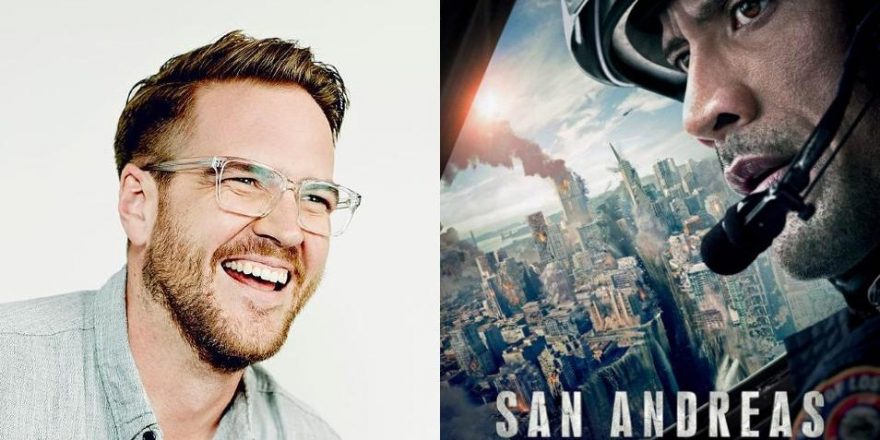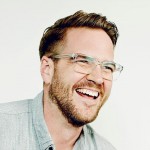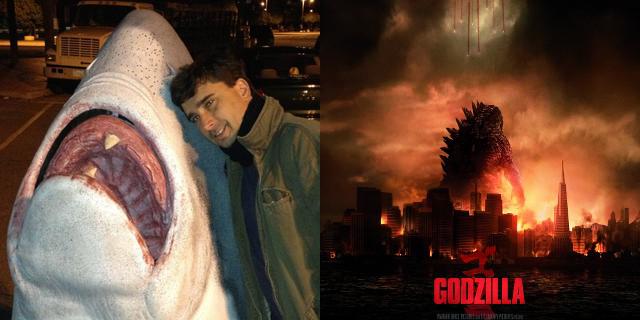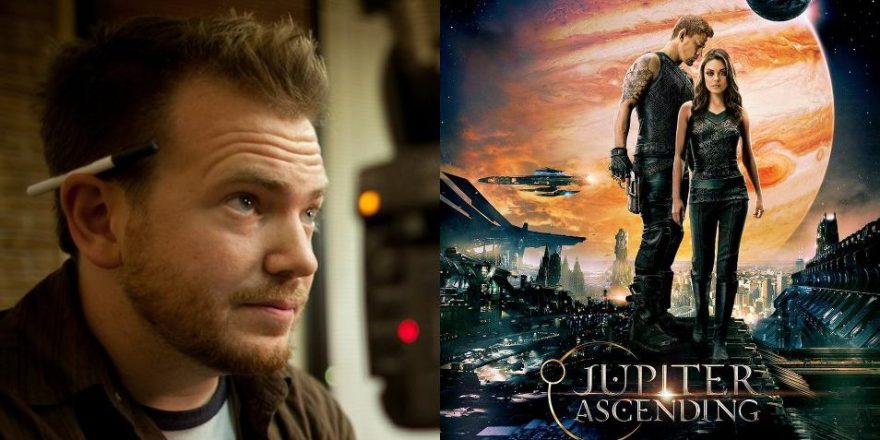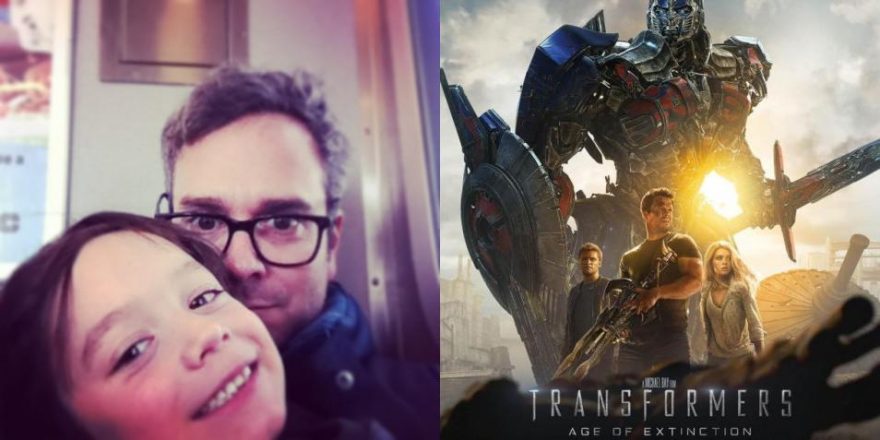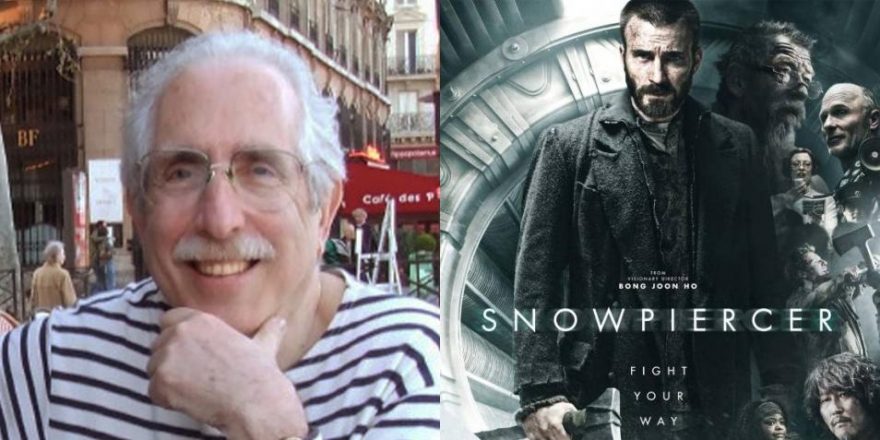I watched San Andreas at a press screening held at the world-famous Los Angeles outdoor mall The Grove. I’d never been to a press screening for anything before. It seemed like most of the folks there already knew each other and were well accustomed to how these things go down. Because of some coup from my editor, I was assigned to sit in the RESERVED section, cornered off by a piece of blue masking tape in the center of the theater. The film started 30 minutes late and that time was filled with much to-do regarding people trying and failing to sit with me inside the blue masking tape section. I was sitting on the aisle and had removed the tape once I sat down. A dutiful Warner Brothers representative came over and promptly put the tape back in place. “Do you mind if I just place this back here, sir? Just to be safe.” (Yes, let’s keep this tape up for our safety! The fucking San Andreas Fault is about to split everything in two and the blue tape will keep us safe!) With the tape back up (and me sitting next to it), I was now the recipient of grievances from anyone coming by hoping to find a seat, who would immediately be disappointed to learn that, for whatever reason, they were not allowed to sit inside the blue masking tape section. I was inevitably forced to apologize to multiple people because of this. And while I was sorry for them, I was also at the same time grateful to have this blue-taped luxury. It was with this separation that I began the collective experience of watching San Andreas….
Having never lived anywhere but California, the looming threat of earthquakes has always been very real to me. I have a distinct memory of visiting San Francisco with my parents shortly after the last big quake in 1989. We were staying with a friend of my mom’s and sleeping on the couch and the floor. I couldn’t sleep because I was so afraid that an earthquake was going to kill us all. I remember my parents being annoyed at having to comfort their seven-year-old boy and explain the infrequency of earthquakes. That said, I feel that if the film San Andreas had existed at that time it might have been all the calm I needed. “It’s OK, sweetheart,” they could have said, “no matter how bad things may seem, The Rock is here and he’ll take care of us.”
Brad Peyton’s San Andreas follows Ray (Dwayne “The Rock” Johnson), a Los Angeles Fire & Rescue helicopter pilot, on a journey across California to save his wife and daughter after a catastrophic earthquake hits the film’s titular fault line. For a film with such expansive shots of destruction, it’s insane how little attention is paid to the mass death we are witnessing. The film is only concerned with Ray (who, for the purposes of this piece, will be referred to as “The Rock”) and his family. The Rock’s San Andreas role represents a full embrace of a new version of the action-movie star. Amidst the posturing (and under all the thick, meaty layers of bicep), there is a genuine teddy bear-like sensitivity in The Rock’s performance that’s rarely seen in these kinds of roles. He’s reached a new plateau where he can bark most of his lines with authority, and then dip into real emotion when the (emotionally thin-as-hell) script calls for it.
The film’s story oscillates between The Rock saving his family and a storyline featuring Paul Giamatti, who superbly plays flustered seismologist Dr. I Told You So (who seems to be completely aware of the absurdity that comes with this type of movie). Although both actors are leads in the film, there is a strong chance that The Rock and Paul Giamatti have never met each other face to face IRL. While The Rock’s journey takes him hundreds of miles from Los Angeles to San Francisco, Giamatti’s scenes (besides an admittedly breathtaking sequence at Hoover Dam) consist merely of him and his colleagues freaking the fuck out over every seismographic printout at their Caltech office, and crawling beneath their desks every time there is a quake.
I actually appreciated the focus of San Andreas. It throws out many of the tropes that started the genre back in the ’70s, in films such as Airport and The Towering Inferno, and also feature in disaster films of more recent years (2012, The Day After Tomorrow, Deep Impact, etc.). These films for the most part rely on cheeky vignettes and the practice of cramming in as many character threads as possible leading up to the disaster. Peyton and screenwriter Carlton Cuse are well aware of this. The reason you buy a ticket to see San Andreas is the scenes of destruction on a massive scale — everything else is just filler. You don’t go see a film like this to learn something new about Family or Friendship or Community, you go so that for a fleeting moment in a dark cinema you can become God (and an angry, relentless, destructive God, at that). These scenes of destruction wash over you, playing out from a POV that could only exist if God his/herself were watching all this chaos take place. God is holding the camera, the world is being destroyed, everyone is dying and he/she is doing nothing to stop it.
Which brings me to the Giant Fucking Wave sequence in the film. The Giant Fucking Wave is a motif that seems to exist in most modern disaster films, evolving over the years along with advances in CGI. The GFW replaces the monster in the monster movie. It is living and breathing a life of its own. There are GFW’s in Interstellar, Deep Impact and The Day After Tomorrow, which, for your viewing pleasure, I’ve compiled into a GFW YouTube mix-tape here. The GFW in San Andreas might be hands down the most effective use of this I’ve ever seen as a set piece, because the characters are not passively being washed over by it. The Rock, in all his glory, manages to hydroplane his way up the crest of the wave in a goddamned speedboat. Even this GFW is no match for The Rock.
The Rock is good — real good. While the audience revels in all the glorious wide-scale destruction scenes, The Rock’s own sheer size makes it impossible to turn away. For scale, just one of The Rock’s Abs = My Head. In any ensemble shot where he is placed in proximity to other actors, you spend half the time just marveling at his sheer size and impressive body-mass percentage. From the moment his character is introduced, he’s filmed in a way that makes his body pop from the screen, always back-lit with a golden glow. The transition to HD, with its unforgiving sharpness and detail, has likely been a nightmare for many actors and makeup departments. The Rock’s face and body, however, were made to be shot digitally. With this guy, the more definition, the better. He is shot so sharply that at times I found my focus shifting to a single bead of The Rock’s sweat.
But while The Rock makes this movie compelling to watch, he is also the reason why San Andreas has zero narrative tension. There is never a doubt in your mind that The Rock will come out of this experience unscathed. He oozes the assurance of safety and warmth from his biceps. Every time you see his wide smile of glistening teeth, a wave of serotonin is released in your brain and there is no doubt that EVERYTHING IS GOING TO BE OK. And it’s with this comfort that the film ends. The Rock stands on the hill above the Golden Gate Bridge surveying the destruction of San Francisco. His gigantic man-arms wrap around his wife and daughter, as well as two other fortunate little stragglers (if you’re good at math, you’ve deduced that his arms are able to envelop four human beings), bathing them in comfort and safety. And this feeling extends to us folks watching as well. Quiet now, the storm has passed, The Rock is here to care for us all.



